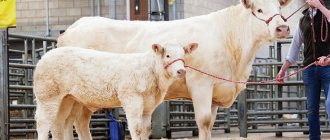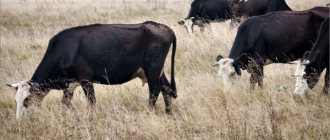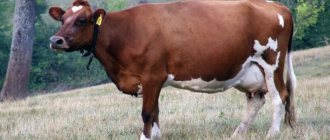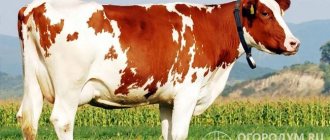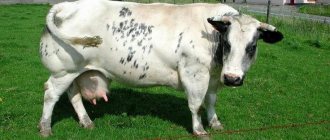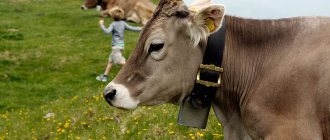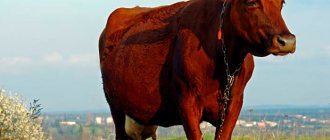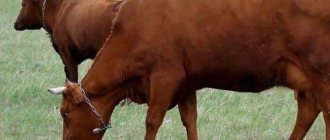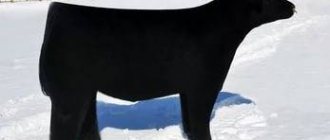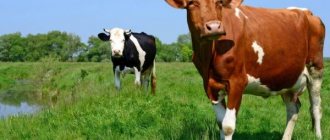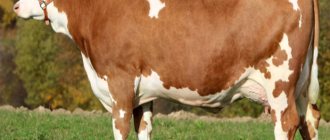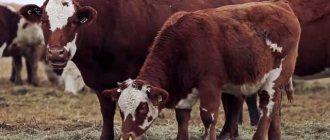Cattle breeders give their preference to the breeds of cows from which they can get the most bang for their buck. These include animals with high milk production and good meat yield at slaughter. Such types of cattle are called universal or combined, and the direction of development of the breed is called meat and dairy. Some farmers distinguish between meat and dairy and dairy and meat types of cows depending on their leading productive qualities. Methods of keeping and preparing a diet for such animals are chosen in accordance with the intended purpose of breeding.
Characteristics of meat and dairy breeds
You can get good returns from cattle of these breeds, so the development of this area does not stand still.
Individuals of meat and dairy breeds have the following characteristic features:
- strong legs of medium length;
- straight back;
- elongated, proportional body;
- the muscles are not very pronounced;
- The weight of animals ranges from 600 kg to 1 ton.
Important! The main advantage of meat and dairy cows is their unpretentiousness and the absence of special maintenance requirements. Cows are suitable for raising on private land, in medium and large farms. They are suitable for keeping indoors and in grazing areas.
Cows that have a universal direction in production can live a long time - 30 years.
Types of breeds
Today, there are three types of breeds, depending on the product they produce to a greater extent:
- dairy;
- meat;
- combined (milk-meat or double).
Breeds of dairy cows produce a large amount of milk (they need to be milked at least 2 times a day), but their meat is quite tough and therefore unsuitable for food. Most of the cows bred on the territory of the Russian Federation belong to this type. Meat breeds are distinguished by tender and soft meat, active growth, but at the same time they produce little milk. Combined breeds are considered universal because they produce the same amount of milk as dairy breeds, but at the same time produce good, high-calorie meat.
Livestock breeding
When purchasing individual cattle for future breeding, it is important to carefully study the specimens and choose the most suitable ones. To make the right choice, you need to pay attention to some criteria:
- the purchase must be made at farms engaged in cattle breeding;
- the animal should look healthy and be energetic;
- no discharge from the nose or eyes;
- the skin should not have damage of unknown origin.
Universal breeds are suitable for crossing with meat and dairy breeds to improve individual qualities. It is important that when crossing animals, representatives of meat breeds do not exceed in size. This is fraught with problems associated with future calving.
Cows can become pregnant every year. The female's readiness to mate is manifested in general restlessness, discharge and swelling of the genitals.
Cows do not require assistance during birth. One calf can be born per pregnancy. When 2 or more calves are born at the same time, the cow is culled and fattened for slaughter, since she is able to quickly gain weight.
The best meat and dairy breeds
These types of combined selections are becoming increasingly popular. They are easier to care for, more adaptable and suitable for all maintenance purposes. The most popular breeds in this area and their productive indicators will be discussed further.
Alatau
The breed was obtained back in the 50s of the last century by Soviet scientists. Foothills of Kazakhstan became their homeland, and since the climate there is more than harsh, the cows are distinguished by their ease of care and good adaptability.
The animals have small legs, but they are very powerful and strong, and the neck and chest are also small. The individual grows up to 130–150 centimeters in height. Growth occurs quite quickly, as does weight gain, and it does not matter at all how the individual eats. An interesting feature of the breed is its saggy butt. Cows are distinguished by their dense and strong constitution and pronounced meat forms.
Productive indicators of the breed:
- weight gain occurs very quickly: bulls grow quickly, in just 6 months they can gain up to 500 kilograms, and then up to 1 ton in adulthood (after 1 year). Heifers gain up to 600 kilograms in one year of life;
- meat yield is 60%. Meatiness indicators are quite high;
- milk is tasty and not very fatty. The fat content of the product fluctuates around 3.9-4.0%. One cow produces up to 4–5 thousand liters of milk per year;
Bestuzhevskaya
It was obtained in Russia, at the turn of the 18th-19th centuries, in the territories of the modern Ulyanovsk region. The selection itself is not purely Russian; genes from European breeds (Dutch, Shorthorn) were used in its creation, to which several local ones were added, obtaining such a positive result. It received its name from the landowner Bestuzhev, who was responsible for the breeding.
The growth of individuals is average, approximately 120–130 centimeters at the withers. The constitution is average, the animals are strong in appearance, with a well-developed skeletal system. They are distinguished by a red color, like the red Gorbatovskys, but with a lighter shade of fur; sometimes there are individuals with a darker type of color. A distinctive feature is immunity - it is resistant to many diseases, including leukemia and tuberculosis. Quite an economical breed, as it calmly consumes rough types of feed.
Bestuzhevki will delight you with the following indicators:
- gain weight quickly, weight indicators are quite high: bulls can weigh up to more than 1 ton, cows - from 400 to 700 kilograms;
- meat yield - above average, no less than 55%;
- milk indicators are very high. They can compete with pure dairy breeds, since one cow produces more than 5 thousand liters of milk per year (and at least 3 thousand liters). Its taste is rich and tasty, its fat content is above average - 3.8-4.0%, and when fed with fresh, juicy green grass it can reach 5.5%.
Brown Carpathian
It was bred in the Carpathians in the middle of the 20th century. It arose from local breeds, the so-called Makonets or Ryzheks, which were crossed with Swiss, Algauz and Swiss individuals.
The constitution is strong, the skeleton is dense and light, the hoof horn is durable, since the cattle adapt well to mountain conditions. The body is short, but the chest is quite wide. The height of the animals ranges from 120 to 130 centimeters; the color is usually light with an admixture of brown and red colors.
Main productive characteristics:
- Weight gain occurs quickly - by the age of one year, bulls gain approximately 350 kilograms. The average weight of an individual is 450–500 kilograms. Adult bulls can weigh up to 700 kilograms;
- meat yield is good, slightly above average. Typically, up to 55–58% pure meat can be obtained from one individual;
- milk production is 3–4 thousand liters of milk per year. The fat content is average - 3.5-4.5%, the product has a delicate taste and good aroma.
Yorkshire
Yorkshire dogs were bred in the mid-18th century in the Yorkshire county, from where they got their name. In the 19th century they spread throughout Europe due to their productive performance.
Cows are distinguished by their red-motley color; shades can vary in intensity. The physique is strong, all parts of the body are proportionally developed. The height of the individual at the withers is approximately 130 centimeters. Outwardly, the cattle look quite powerful, but in reality the animals are friendly and calm.
These cows have:
- weight gain is very fast, much more intense than that of other representatives of combined cattle breeds. The live weight of a cow varies around 500 kilograms, the weight of adult bulls is approximately 800 kilograms;
- meat yield is average, approximately 45–50%;
- milk indicators are very high, milk yield can be 4.5-5 thousand liters of milk per year. Fat content - from 4.4% to 4.6%.
Caucasian brown
It was developed by Soviet scientists in the 50s of the last century. It appeared throughout the Caucasus, since breeding centers were scattered, therefore there are still disputes regarding the homeland of the breed, some consider it Armenia, others - Azerbaijan or Dagestan. It was bred from Caucasian breeds mixed with Swiss, Kostroma and Lebedinsky cows.
The body of these cows is dense, the legs are strong but short, the physique is tall and strong. The animal looks strong and hardy, has a thick skin and dense hair, so it tolerates climate change and temperature changes well. The color is mostly close to brown in different shades. Height is short, about 120 centimeters at the withers, rarely exceeding 130 centimeters.
Productive characteristics of Caucasians:
- weight gain occurs relatively quickly. Cows weigh approximately 600 kilograms, bulls - 850–900 kilograms;
- meat yield - 50–55%, no more;
- milk indicators are unique and ambiguous. In general, it will not be possible to obtain large milk yields - a cow produces no more than 3.5 thousand liters of milk with a fat content of 3.5%, which is quite a bit. But in terms of its characteristics, it is more than unique - the taste is so high that it is often used to make delicacies and delicious expensive cheeses.
Kostromskaya
The breed has an interesting breeding history - it was created during the war specifically to quickly obtain high-quality products. It was officially registered in 1945 in Russia and is considered one of the best meat and dairy breeds.
These are long-living animals with a strong, stately build and average size. The body is well developed, but the legs are short. Resistant to many diseases, especially leukemia. The color can be red or gray, with all shade options.
Basic characteristics of the breed:
- weight gain is relatively fast, bulls gain 900 kilograms, heifers - approximately 550-700 kilograms. Calves are born medium-sized, weighing about 40 kilograms;
- meat yield is 65%, therefore the breed can compete with others in this regard;
- milk indicators are uniquely high - they equal 4-7 thousand liters of milk per year (fat content - 3.9%). It has a high lactose content, about 5%, so the product stands out significantly from the rest.
Red Gorbatovskaya
It was developed in Russia in the last century. Received selection by crossing local and Tyrolean cows.
The breed itself is small; usually an individual is no more than 120 centimeters tall. Visually, the animal looks elongated, this is due to the fact that the back is quite wide, and the chest is only 35-40 centimeters in size. The back is often sagging, the udder is small and well developed. The color, as the name implies, is mainly red, bright and saturated, sometimes there may be splashes of white. Most often, cows are lighter in color than bulls. They have good immunity and are valued for their high resistance to many dangerous diseases, including infectious ones, especially leukemia, brucellosis and tuberculosis.
The most important indicators:
- weight gain is average, since the growth of the cattle is small. Cows weigh 600 kilograms, bulls - 900. Calves are born small, weighing only 25–28 kg;
- meat yield - average, 55%;
- milk indicators are small, approximately 3 thousand liters per year, but it is distinguished by high fat content - from 4.2%. Sometimes milk and 6% fat content are found.
Red Danish
Red Danes were bred in the mid-19th century from the Angler breed. In the selection, representatives of Shorthorn cattle were crossed with the above-mentioned breed; often purebred Danish bulls also took part in the insemination process, which passed on many advantages to the Danish Reds, such as a strong physique and body weight.
The height of the animal at the withers fluctuates around 130 centimeters. The physique of representatives of Danish cows is strong, the body is long and wide, the rear part is quite wide, and the sternum is large. The legs are of medium length, as is the neck, the skeleton is generally strong, the horns are set widely. A well-developed udder is cup-shaped. The main color of cows is red, but a darker shade is also found. In cows, sometimes the udder or lower abdomen is covered with a small number of medium-sized white spots.
Danish cows have:
- Weight gain occurs quickly, like other representatives of meat and dairy breeds. The weight of cows often fluctuates; according to breed standards, it can range from 550 to 800 kilograms. Bulls gain more than 1 ton. Calves weigh approximately 35 kg at birth;
- meat yield at slaughter is average, exactly 50%;
- Milk indicators average 9 thousand liters of milk per year, which is a lot. In conditions of good maintenance and proper feeding, even greater figures can be achieved - from 11 to 18 thousand liters per year. The fat content of the milk is high, 4.2 (the amount of protein is 3.5%).
Examples of universal breeds
Breeders all over the world are engaged in breeding cattle breeds for meat and dairy production. There are already more than a dozen of them. But not all species have become popular among breeders.
It should be noted that there are common varieties that have received preference due to the benefits of their breeding.
Bestuzhev cow
Bestuzhevskaya
The oldest of the Russian breeds (bred in 1780). Belongs to the milk-meat type. Animals of this breed have a strong build. They grow up to 130 centimeters. The weight of adult animals ranges from 550 to 900 kg. Daily body weight gain is 850 grams, even when eating roughage. Meat yield at slaughter is 60%. The milk production level is 4000 liters of milk per year. The fat content of the product is about 4%. The milk has a rich taste.
Animals are disease resistant and unpretentious. They have strong immunity, so they are not prone to leukemia and tuberculosis.
Alaut cow
Alautskaya
Representatives of the Alaut breed have good productivity indicators. They are adapted to breeding in high mountain areas.
External data:
- strong physique;
- straight, wide back;
- neat udder;
- brown color;
- oblong, large head.
The weight of adult cows is from 500 to 1000 kg.
The annual level of milk production is on average 4500 liters. Milk fat content is 3.5-4%. Suitable for milking by machine or manually. Meat yield at slaughter is 65%.
Schwyz cow
Shvitskaya
A meat and dairy breed with correct proportions in the structure of the body and strong bones.
The body weight of adult cows can reach 900 kg. The yield of beef at slaughter is more than half of the live weight of the individual.
Important! Milk productivity is 4000-5000 liters per year. Fat content of the product is 3.5-4%.
Kostroma breed of cows
Kostromskaya
The breed has become widespread among breeders due to its production indicators.
Animals look good in appearance, have graceful body contours, a strong skeleton, and developed muscles. Among the representatives of this breed, light gray color predominates. Sometimes there are shades of brown.
Kostroma cows are large in size. Their weight can reach 1.5 tons.
Milk productivity – 5-6 thousand liters per year, fat content – 4%. This is one of the most profitable breeds for breeding.
Among the advantages:
- high meat and milk productivity;
- delicious beef;
- rapid weight gain;
- a large percentage of meat yield at slaughter - about 60%.
But in order to achieve good performance, it is important to strictly adhere to the feeding regime and regularly graze livestock on pastures.
Brown Carpathian cow
Brown Carpathian
From the name it is clear that the birthplace of the breed is the Carpathians.
Individuals have:
- strong skeleton;
- correct physique;
- horns of medium length, growing predominantly upward;
- large sternum;
- shortened body;
- strong hooves.
Cows grow up to 130 centimeters. Shades of brown and red colors predominate.
Animals gain weight quickly. By 1 year they reach 350-700 kg. Meat yield at slaughter is up to 58%.
The annual milk yield is up to 4000 liters of milk. Fat content of the product is 3-4%.
Simmental cow breed
Modern cow breeds
Private breeders and large farms have cows of different breeds for different tasks. Some sell beef, others make cheeses, cottage cheese and milk, and still others sew shoes and belts. According to the purposes of raising and breeding, cattle are divided into breeds:
- dairy;
- meat;
- meat and dairy
There is a visible difference between the appearance of beef and dairy breeds. Varieties of “burenok”, bred for beef, have a body shaped like a rectangle or square. But for animals with an increased volume of milk production, a triangular body shape is characteristic, where the base of the isosceles geometric figure falls on the rear part.
Milk cows
If the ancient ancestors of domesticated cattle produced 0.4-0.5 tons of milk per year, then thanks to the selection work of modern specialists, some cattle breeds, with proper care, produce up to 20 tons in 12 months.
Popular dairy cow breeds include:
- Dutch;
- Holstein;
- Jersey;
- red steppe;
- black and motley.
Dutch
The Dutch breed of cattle was bred by specialists from the country of the same name. The milk variety is the longest living in the world. Cattle of this species have three subtypes. Animals are used both to produce fermented milk products and in breeding experiments to breed new breeds in a certain area.
The main subspecies of the Dutch breed are the Friesian, Groningen and Meuse-Rhine-Isel milk cows. The first animals have a black and white color, Groningen individuals have a white head and an orange or black body, but the last group includes red-variegated shades.
Milk of Dutch varieties has an average fat content of 3.5-4%. Adult bulls reach a weight of 1 ton, and cows 0.75 tons. In 12 months, one cattle is capable of producing 4.5 tons of products.
The life expectancy of cattle is 25-30 years.
Universal Holstein
Another representative of dairy breeds is the Holstein variety of cattle. Animals quickly adapt to environmental conditions, while some of the qualities that make up productivity change.
The weight of Holstein bulls usually reaches 1.2 tons. Cows in adulthood “eat” up to 0.75 tons. The breed, widely known throughout the world, is also popular in our country, while in private individual ownership or in large farms there are 2 varieties - black and red and white. The fat content of the milk of the former is 3.8%, the latter give milk yield with an indicator of 3.96%.
Miniature Jersey
The Jersey dairy cattle breed is a type of miniature cow. These animals produce relatively small milk yields over 12 months - from 3 to 3.5 tons, however, their dairy product has a high fat content of 5-7%.
Animals of this breed can be distinguished by their light colors and short muzzle with a flattened nose and depressed forehead. Adult Jersey cows weigh 0.36-0.4 tons, and bulls “eat” a maximum of 0.7 tons. The weight of calves at the time of birth does not exceed 20 kg.
Red steppe
Once upon a time, Ukrainian breeding specialists created a breed of cattle called “Red Steppe”. Animals with a characteristic rusty-red color and sometimes a white spot appeared from crossing several foreign breeds with wild steppe horned individuals.
The Red Steppe breed has been bred for over 200 years.
The product of Ukrainian breeders is popular among cattle breeders in Kazakhstan and Siberia. The Red Steppe stock has tasty meat despite the fact that the breed is dairy. The weight of adult males is 1 ton, and females - 0.6 tons. The fat content of milk is 3.7-3.8%, and in 12 months, under good conditions, a cow produces 5 tons of milk.
Black-and-white pet
One of the most beloved breeds among breeders is the black and white breed. Despite the fact that the animals appeared only in the last century, they differ from their counterparts in their horns and udders in their high milk yield. In 12 months, white and black cows, which is the natural color of the cattle, produce up to 5 tons of milk.
Some experts in the characteristics of cattle mention that in rare cases, milk yield can increase by 3 tons. The weight of calves at birth is 35 kg. An adult cow weighs 0.6 tons, and a bull weighs 0.9 tons.
Meat types
The breed of beef cows is well known and popular among breeders. A characteristic difference between these animals and dairy species is the rapid gain of muscle and fat mass. The description of beef cattle is that they have very developed muscles.
The most popular beef cattle breeds on the market are:
- Aberdeen Angus;
- Hereford;
- Znamenovskaya;
- Ukrainian meat;
- Charolaisian.
Voronezh selection
The Aberdeen Angus variety belongs to the Voronezh selection. Such animals feel great in almost any climatic conditions and grow very quickly. The weight of an adult male is 0.8 tons, and sometimes the result is even 1 ton, but cows in adulthood weigh from 0.5 to 0.6 tons.
The color of the cows of the breed ranges from black to red-red. The animals are short at the withers. In terms of yield, beef is 60%, and bones are 17%. Experts note that Aberdeen Angus meat is soft with a light layer of fat. A breed with a very low milk yield, only 1.7 tons in 12 months.
Hereford
One of the meat breeds that produces delicious beef is the fruit of English breeders called the Hereford breed. The stock has the characteristic Viking red coloration with a white head, chest, tips of the legs and tail. The muscular body has a barrel shape.
An adult Hereford bull weighs 1 ton, and a cow weighs up to 0.6 tons. At slaughter, the yield of beef is 70%, which is one of the best indicators among meat breeds. Hereford animals quickly adapt to their environment.
For the winter, northern cattle breeds are covered with wool.
Ukrainian selection
The meat miracle of Ukrainian breeders is the Znamenovskaya cattle breed. The livestock of this species is one of the miniature ones. The color of the animals is usually black and white, with the predominant dark color on the back, sides and head. Cows are muscular, especially their hindquarters. Due to their miniature size, adult bulls gain weight up to 0.7, and cows - up to 0.55 tons.
Despite the fact that the breed is a meat breed, it has good milk yield. Soft, high-quality shoes are made from animal skin.
Another creation of Ukrainian specialists is the Ukrainian beef breed of cattle. Animals are unpretentious to food and happily eat everything that is given to them. Bulls of the breed gain weight up to 1.2 tons, and cows up to 0.7. On average, the animals produce 55-60% high-quality beef.
French miracle
A meat native to France, the Charolais breed. The animals have white to milky short hair, and in appearance they resemble a “gym muscleman.” Cattle quickly gain fat mass, which eventually turns into meat.
Cows “eat off” to a weight of 0.7 tons, and adult bulls weigh 1.2 tons on the scales. The weight of newborn calves usually starts at 40 kg. It is noteworthy that females of the Charolais variety are 10 cm taller than males.
Milk and meat
In addition to meat and dairy cattle, there are mixed species of animals that produce tasty beef and a lot of fatty milk. Among these breeds, called “meat and dairy”, the following are popular:
- Bestuzhevskaya;
- Kostroma;
- Simmental;
- Swiss
Speaking about meat and dairy cattle breeds, one cannot fail to mention the Bestuzhev type. The animals are the result of the productive work of breeders in the Ulyanovsk region.
Bestuzhev cattle are distinguished by their large muscular build and red color with white spots. Stocky bulls with an elongated body in adulthood reach a weight of 0.9 tons, and cows - 0.55 tons. Burenki produce 3-4 tons of fat milk in 12 months with an indicator of 4.1%, and their beef yield is almost 60%.
Natives of Kostroma
Light gray large animals with developed muscles are excellent representatives of the Kostroma breed. The beef and dairy cattle population was obtained as a result of crossing foreign and domestic breeds of the region of the same name.
Young animals grow and gain weight very quickly. Kostroma bulls weigh up to 1 ton, and females weigh 0.65 tons. Over 12 months, the milk yield of milk, the fat content of which reaches 4%, is 4-5 tons, while the yield of high-quality beef is not lower than 60%.
Simmental cow
With the participation of Simmental bulls, domestic cattle breeders developed such cattle breeds as the Far Eastern, Ural and Siberian. Animals of the Simmental meat and dairy breed are usually painted in a rusty-red or pale-colored color.
Adult males reach a weight of 1 ton, and in cows the figure is slightly lower and stops at 0.65 tons. The yield of beef is not inferior to meat breeds, and in 12 months from one cow you can collect 5 tons of milk with a fat content of 3.9%.
Shvidskaya from Switzerland
The Swiss breed of meat and dairy cows includes the Swiss breed, popularly called “Swedish”. The animals are dark or light brown in color, and their muscles are well developed. Cattle are used both for milk production and for beef production.
The weight of adult bulls reaches 1 ton, and cows - 0.6 tons. The yield of high-quality meat is almost 60%, and over 12 months, milk yield with a fat content of 3.7-3.8% per cow exceeds 4 tons. The breed is actively bred by both domestic cattle breeders and US farmers.
In order for the chosen variety of cows to “give 100%”, proper care and nutrition are necessary. When choosing cattle, it is worth remembering that, adapting to a particular area, milk yield or the percentage of beef yield may change.
